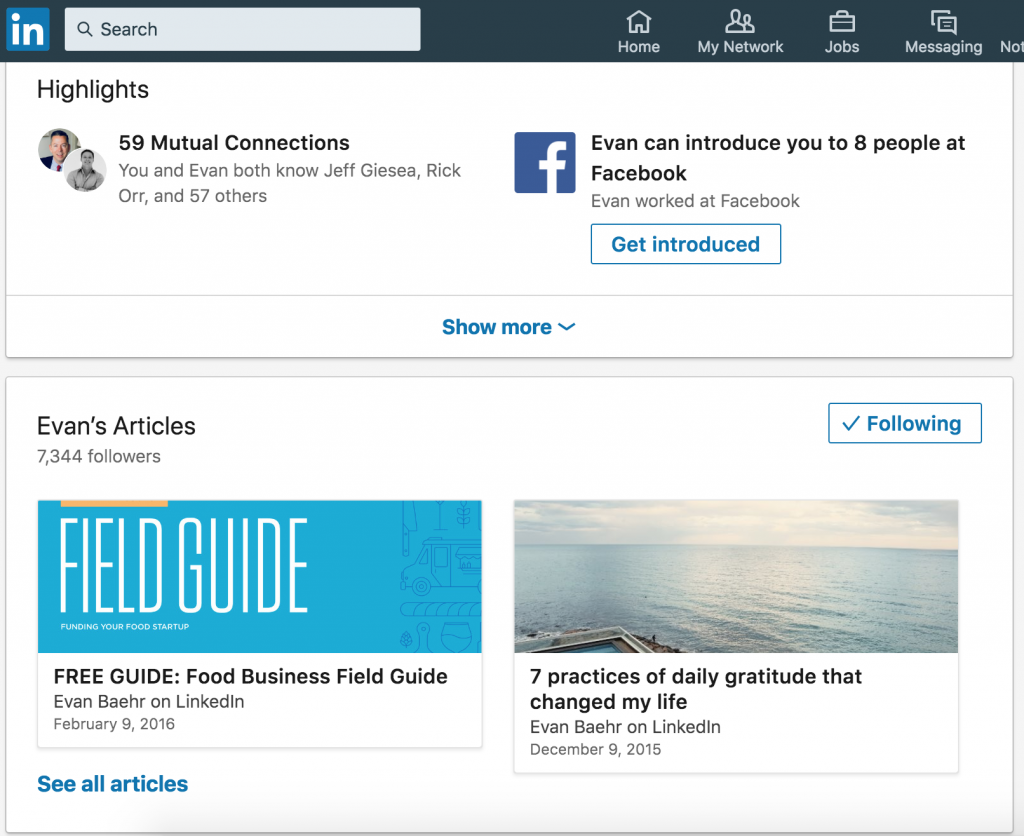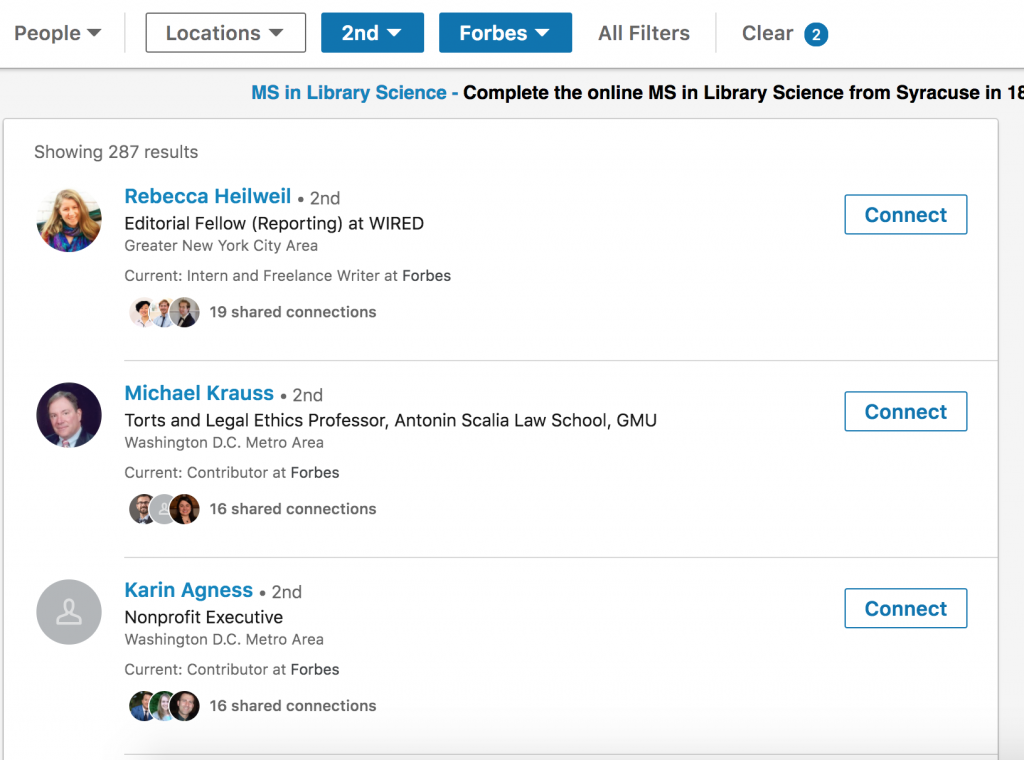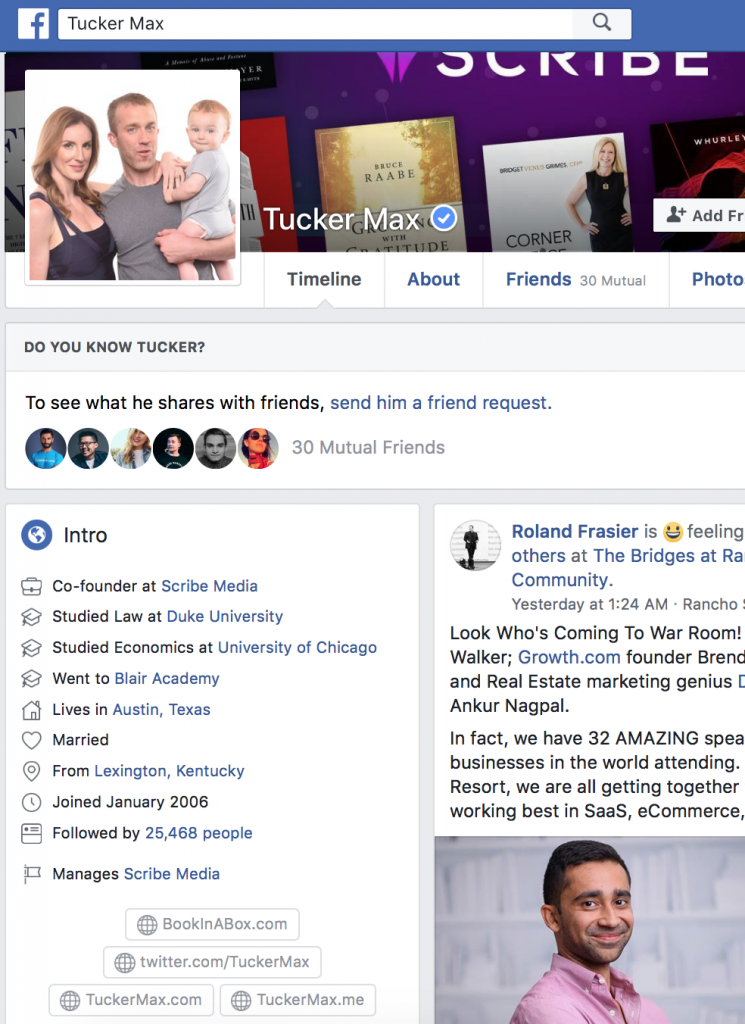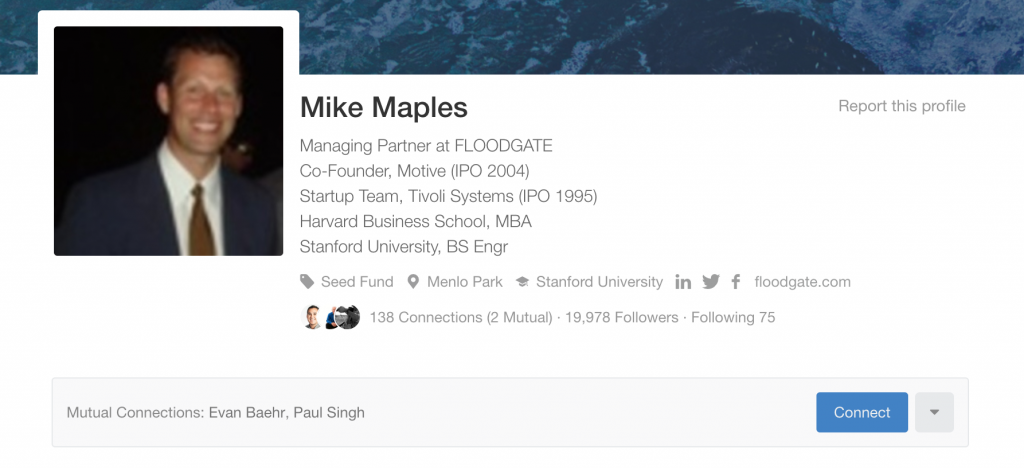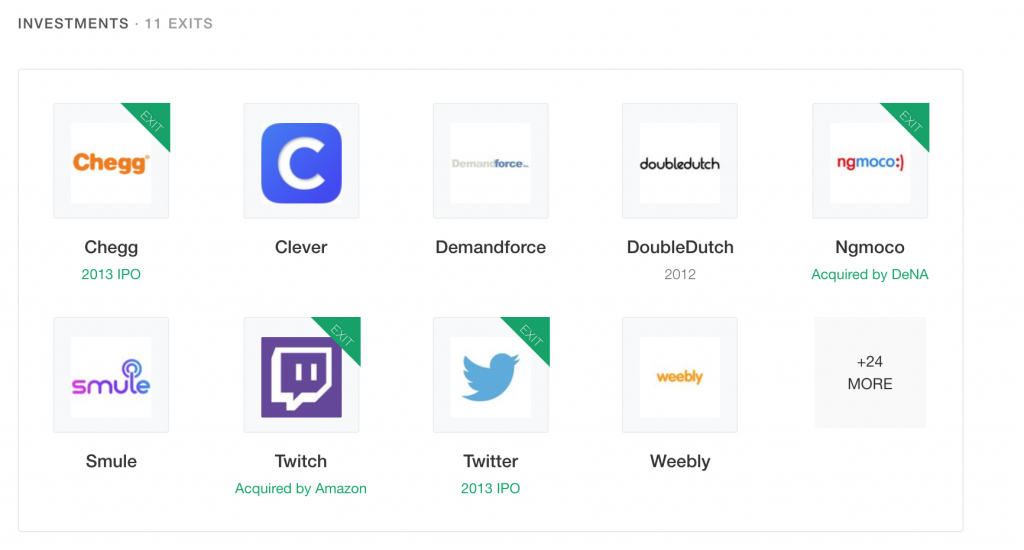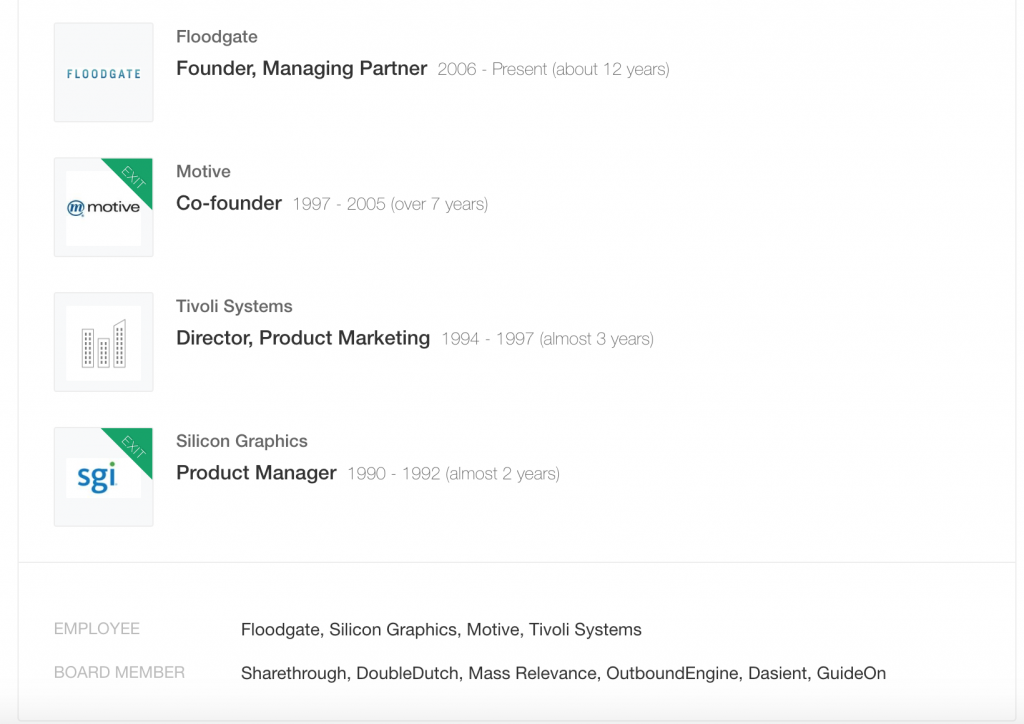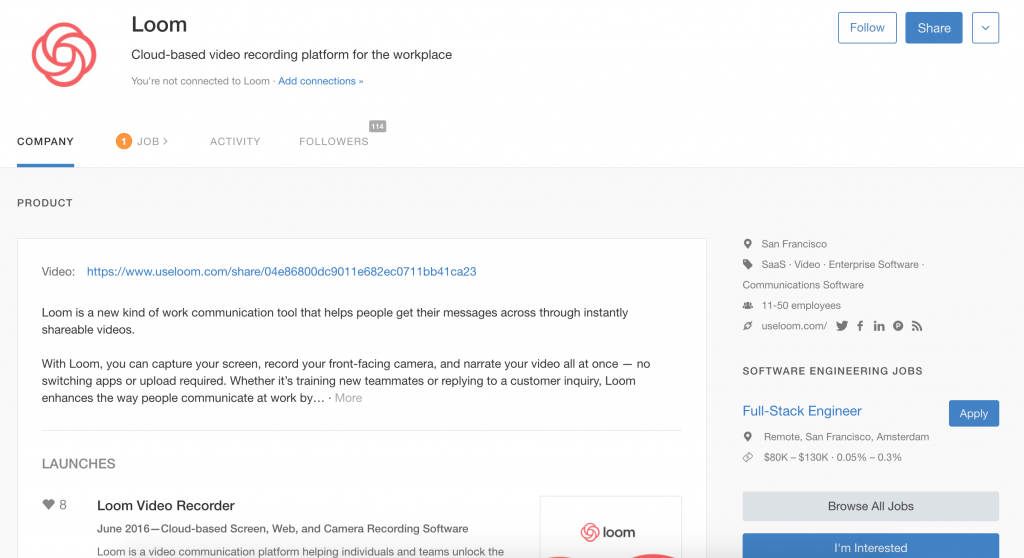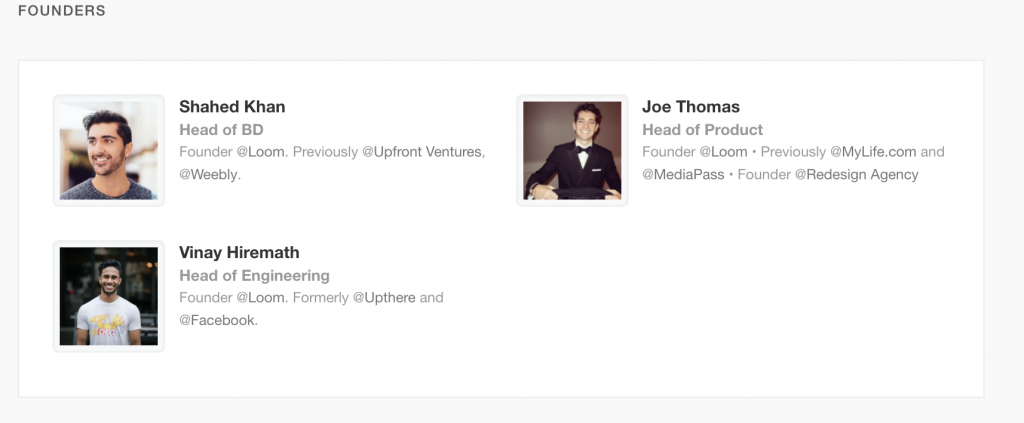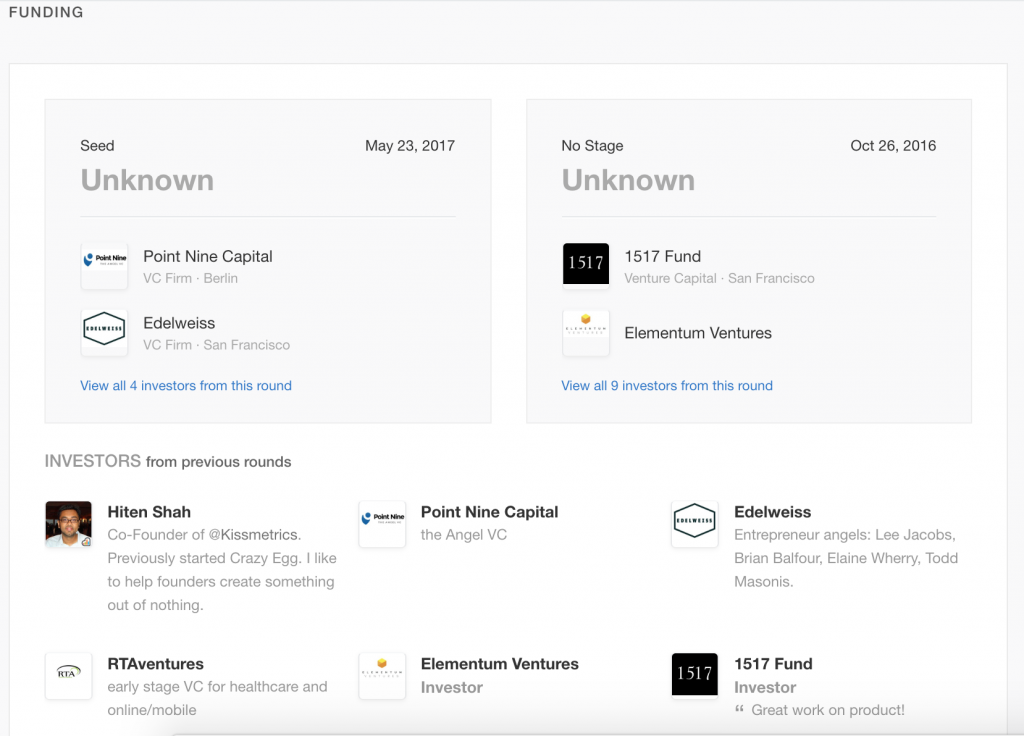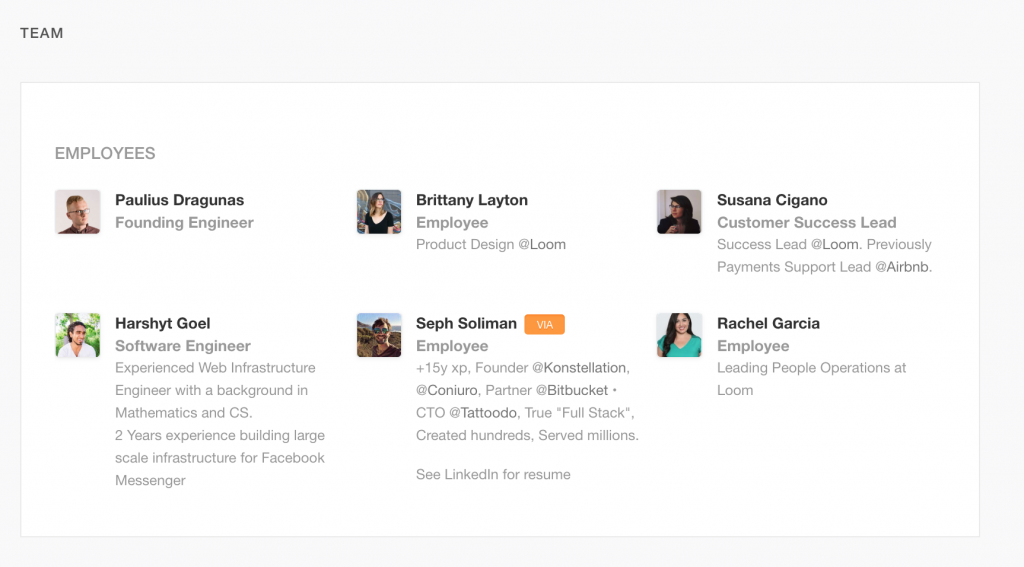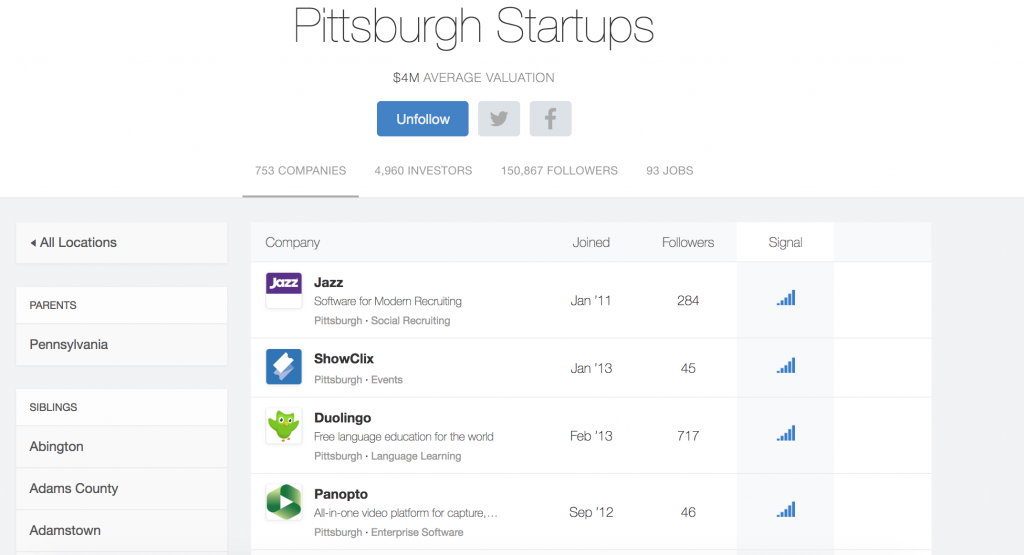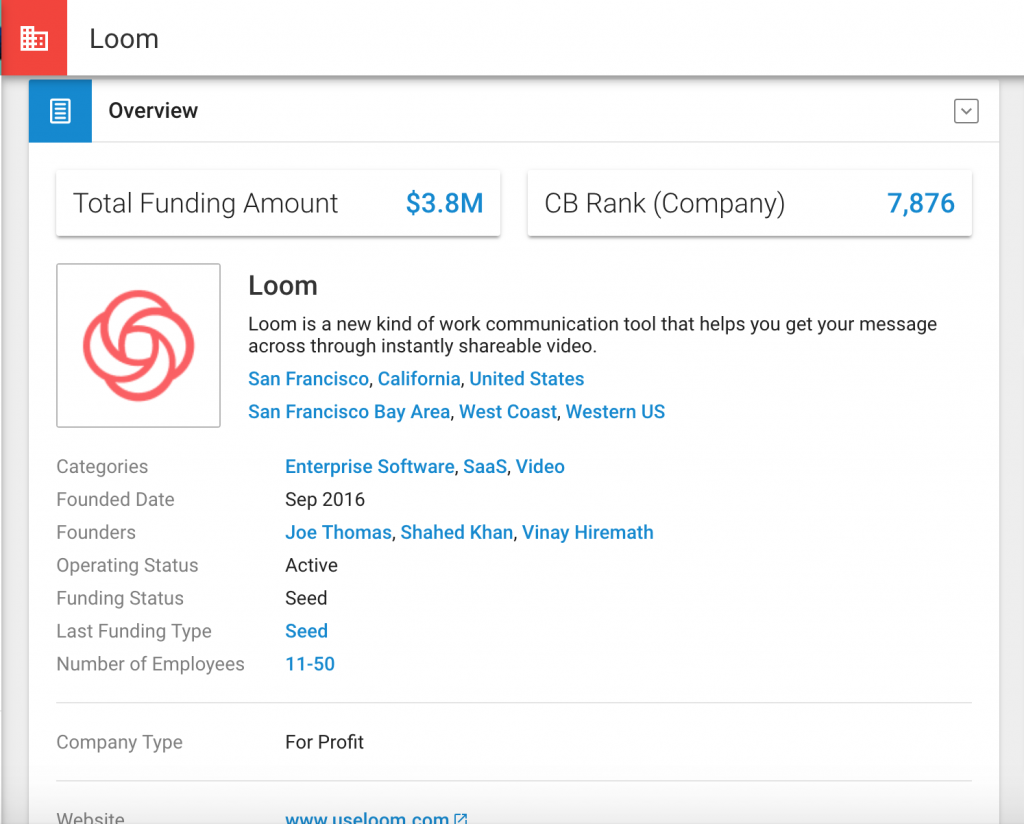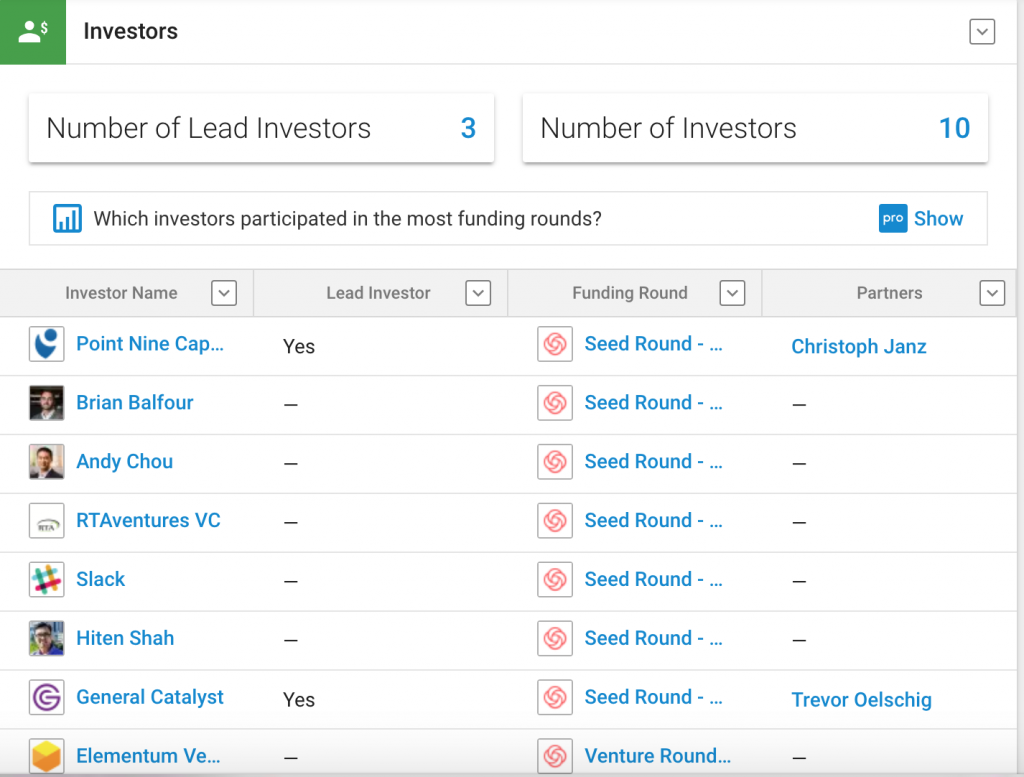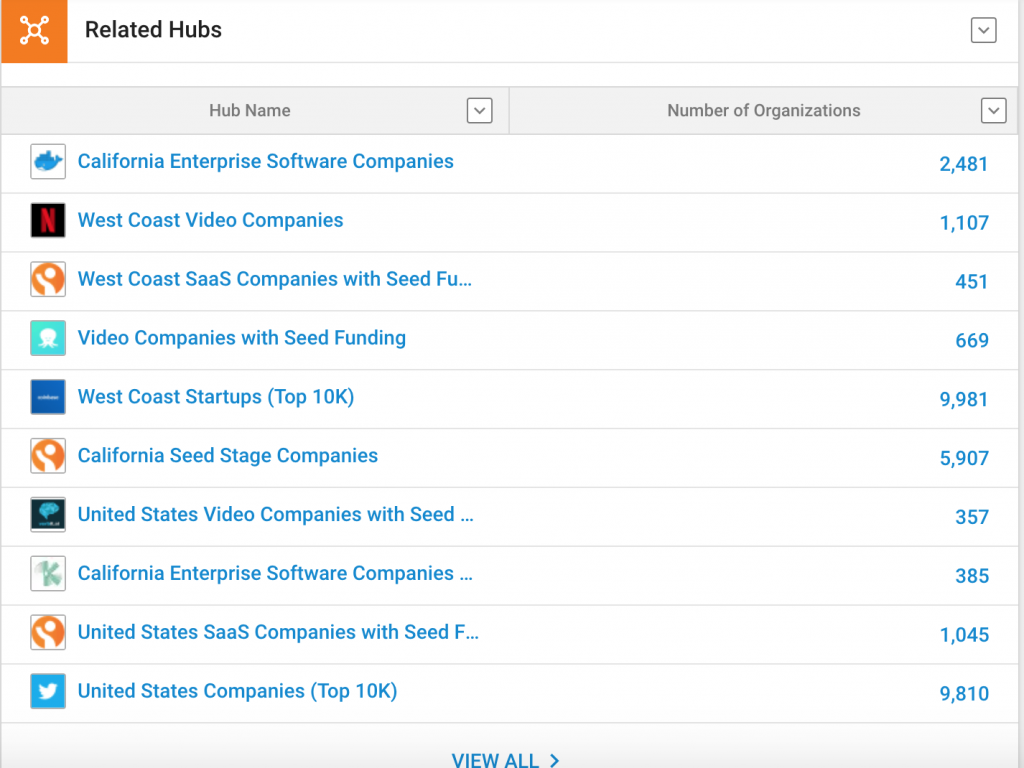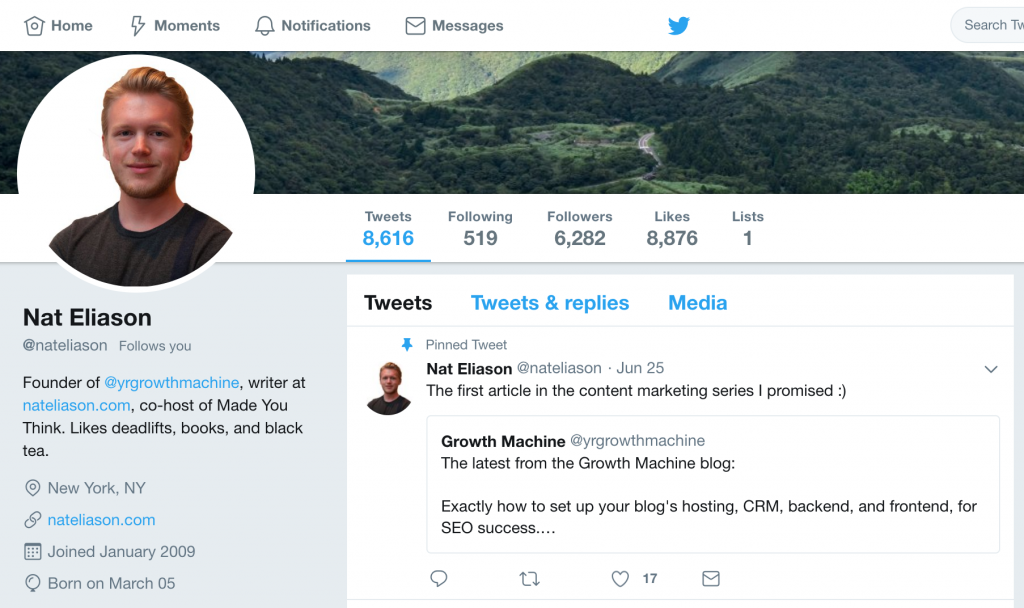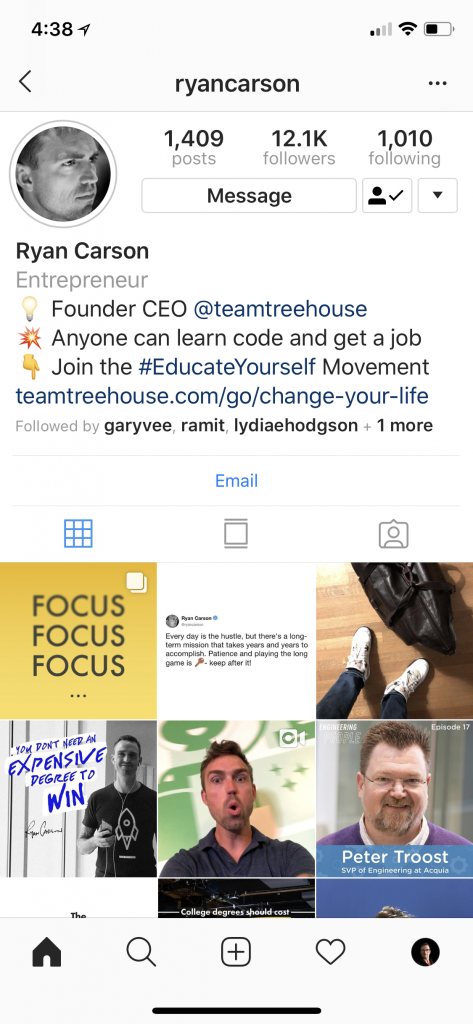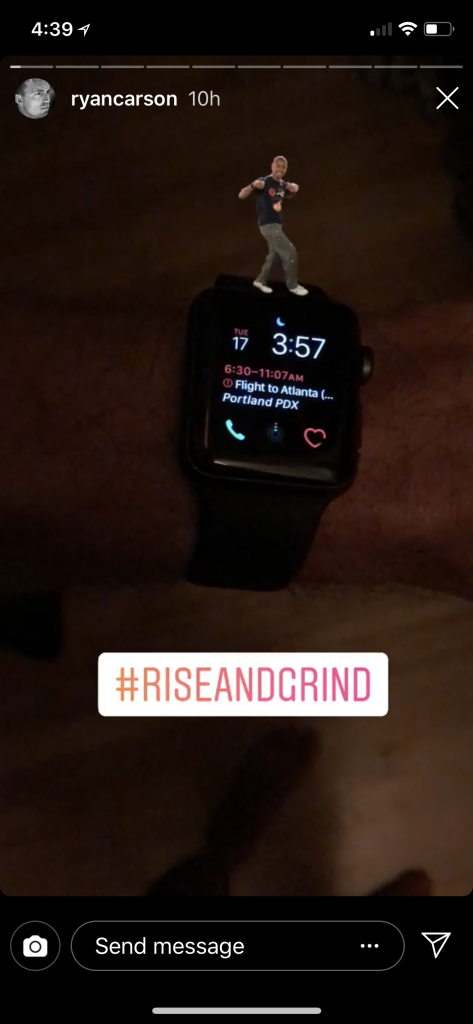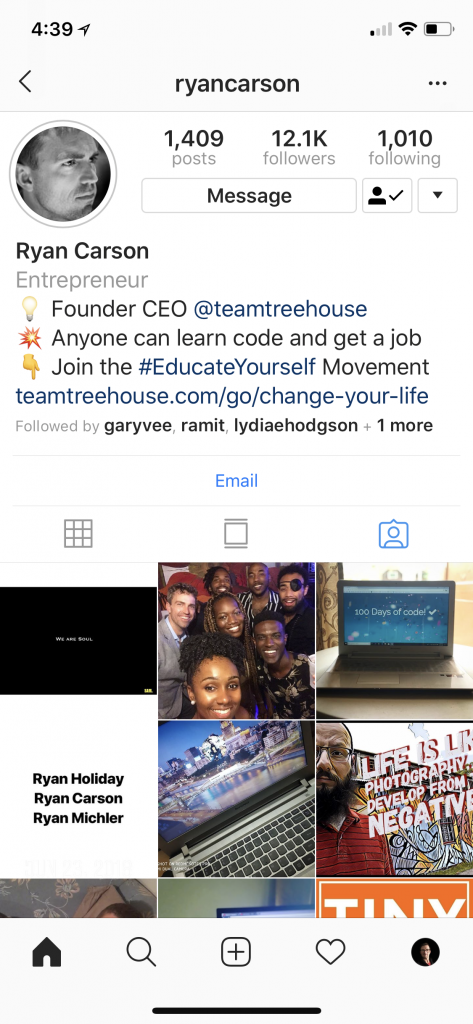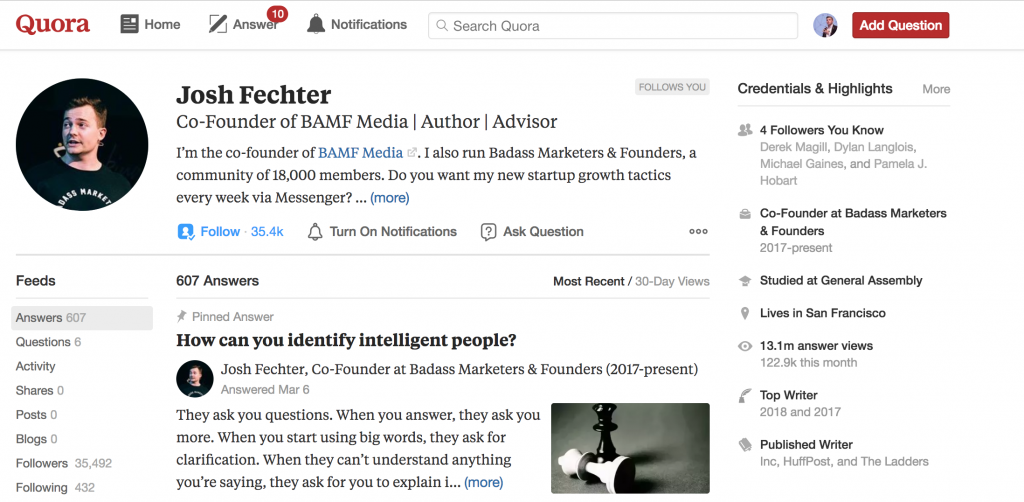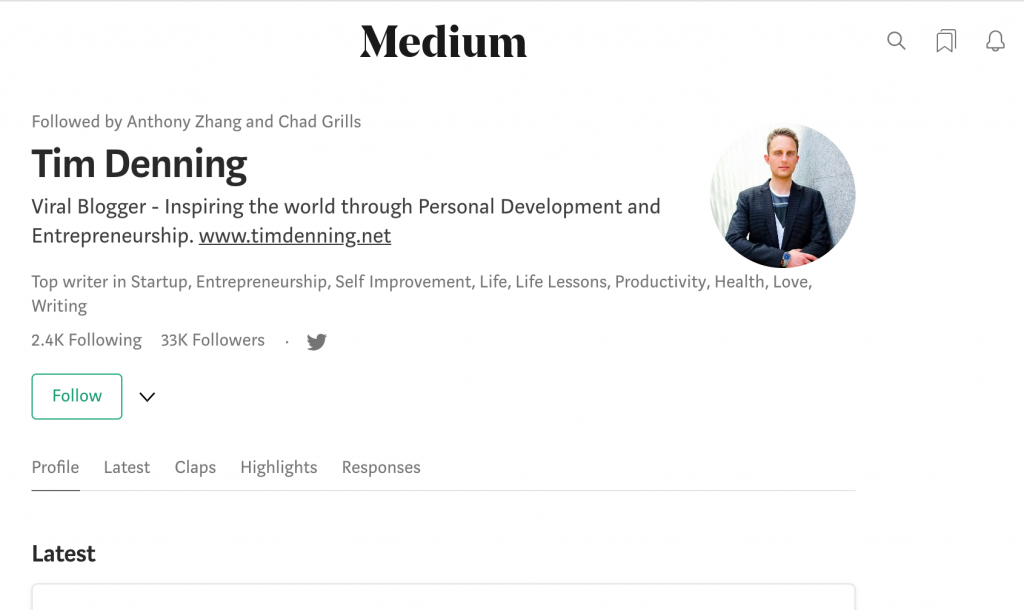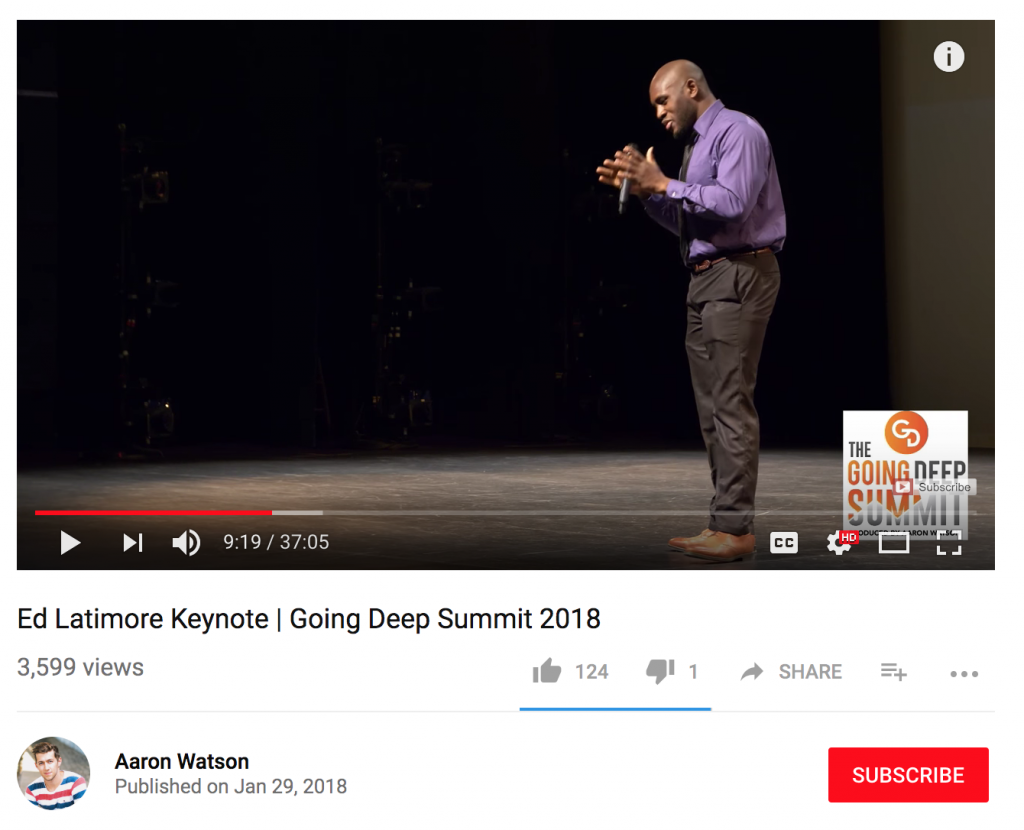I recently met a number of young professionals at an event who asked me how, when it comes to sending cold emails, they could send 1000 more every day. I asked them why they wanted to do that. Inevitably, the answer came back to “isn’t it always better to do more outreach?”
No.
It’s not.
It’s better to do more quality outreach. Sending cold emails won’t help your job search or sales cycle if every email you send gets ignored by Very Busy People. Emails that look like spam (i.e., the kind of email somebody sends 1000 times in a day) get ignored by the vast majority of Very Busy People you want to talk to.
Doing quality outreach means doing research on your targets before you email them. This research does a few things.
- It prevents you from putting your foot in your mouth when you email them. I get people sending cold emails to me for ICOs telling me that they think they’re relevant to me for the work I do in the crypto space. I don’t do anything in the crypto space – if I did, I would want them to reference what I did so that I knew their email wasn’t just spam. Basic research can help you not look silly.
- It gives you points of mutual rapport. Points of mutual rapport help you speed up the relationship-building process by showing the other person that you share some values with them. These may be taste-based values, like that you both like the same football teams. These may be more complex values, like that you share a religion or membership in a values-based fraternity.
- It signals to the person you aren’t a jerk. If you want somebody to give you their valuable time, you should signal to them that you’ve already given up some of your valuable time before reaching out to them.
I have my coaching clients do active outreach and business development — whether that’s for their day jobs or for their consulting businesses — and stress the importance of doing research for them. It pays off.
One client told me last week that the research worked. He received a reply from somebody he sent a cold email to where she explicitly told him, “I usually don’t reply to sales emails but I wanted to reply to yours because it was obvious you did research on me.” That cold email translated into a call in less than two days. I have a copy of that interaction below.
Research works. Do it. View it as an up-front investment in the relationship you’re building with another person.
How Much Research Should You Do?
How much research you do is a function of how important the relationship you want to build relatively is.
If you’re just trying to get somebody to buy a basic SaaS product and you know that you will hit your quota with enough swings, you can get by doing less research. If you want to get your dream job and the person you’re reaching out to might be your boss, you want to do more research. If you’re fundraising for your startup and looking to meet with investors (who 1. are inundated with cold emails all the time and 2. sometimes suck if you don’t do your research on them), you want to do more research.
For my clients running consulting businesses, I encourage them to do enough research that they can establish a good point of rapport and show that they aren’t just blasting out the same email to the same person.
This means looking for values-based connections. These can be a few things:
- Did you go to the same school?
- Are you from the same region?
- Do you have mutual friends?
- Do you have mutual business connections?
- Do you both share a niche interest?
- Do you share interests in the same books?
Same school is a quick and easy point of rapport. You can filter for it on Facebook and LinkedIn. You can attend alumni events (yes, even if you’re a dropout).
The important thing here is to be sincere. Don’t BS your points of mutual connection and rapport. People see through BS quickly (and if they don’t at first, they will in the long run). You want to give them enough to make it easy for them to reply and not think that you are a total time-suck who is just spamming them.
What you want to look for in that point of mutual rapport is a hook. For our purposes, a hook is a point of mutual rapport you can use to either start a conversation or signal that you did more than cursory research.
A quality hook is unique and specific. Unique means that it isn’t something that every other person reaching out to the Very Busy Person references (this is why I don’t like traditional sales research tools too much). Specific means that it references something that, if you mentioned it to the Very Busy Person, they would know you did actual work to find that information out.
Research Resources for Sending Cold Emails
The resources you use for research before sending cold emails changes depending on what your context is. Generally speaking, you want to rely on LinkedIn, Facebook, and Google as your core tools.
See also: How to Send Sales Emails After Connecting on LinkedIn
If you don’t know how to use LinkedIn, learn. Too many people only use LinkedIn when they need to find a new job. LinkedIn is not just for job searching. It’s a tool for establishing your own personal brand and for doing research on others.
In the most recent (Summer 2018) update to LinkedIn, you can see the most important elements of somebody’s profile in a section called “highlights.” This features people you may both know and who the person can introduce you to.
Consider this example from Evan Baehr’s profile:
You can also see the person’s articles. LinkedIn used to emphasize long-form blogging on the platform, so this is a good place to see what the person writes about. If you (actually) find value from their articles, tell them in your email and be specific of what value you found.
Go through the list of people you’re both connected to (if you are not yet connected to your target, these people will appear as “shared connections”). You may be surprised as to the people on the list.
Here’s an example if you’re looking to connect with somebody who is a contributor at Forbes Magazine:
If you have a cluster of connections with somebody, there’s probably an obvious reason. Rebecca and I both went to Penn around the same time, for example, and all of our shared connections are Penn alumni. If somebody sticks out to you as an unusual connection, you can include that as your point of rapport with the person.
“PS – I saw that you’re connected to [odd-person out] on LinkedIn. How do you know him? We both went to summer camp together when I was in high school!”
This shows the target you took time to craft your email and actively thought about their connections while doing research on them.
You can also look at shared groups on LinkedIn. Myers Briggs Type Index (MBTI) groups are popular, for example, and you may find that you share an MBTI type with somebody. This gives you a hook in for a conversation.
Surprisingly few people use Facebook when doing research on targets for jobs or sales outreach. If you think of LinkedIn as the realm of the professional and Facebook as the realm of the personal, get rid of that idea now. Both are realms of the professional and personal.
Mutual friends on Facebook can be more powerful than mutual connections on LinkedIn. If you’re friends with somebody on Facebook, that means that you actually know and have talked to that person (for most people). If you’re connected on LinkedIn, you may have just emailed with them as part of a sales process (or accidentally connected due to LinkedIn’s annoying tendency to email all of your contacts asking to connect).
Let’s use the example of reaching out to Tucker Max, cofounder of Scribe Media and author of numerous books, like I Hope They Serve Beer in Hell.
Instantly, I see a few things I could ask Tucker about in an email (or people I could ask for an introduction — remember that introductions carry considerably more weight than a cold email).
The most interesting point to me, here, is that I have 30 mutual friends. Most of those mutual friends fall into the “online entrepreneurship” or “digital marketing” buckets. These are low-connection buckets and the likelihood that I have a good connection in both directions (from me to the mutual friend and from the mutual friend to Tucker) is low.
At least one doesn’t fall into those buckets. That friend falls into the “also lives in Austin, TX,” bucket. That’s interesting. That means they may have interacted in-person at some point outside of asking questions after a talk at an event.
So, I would first ask my mutual friend if she could do an introduction. If she couldn’t, I’d ask her how she knows him to see if I could learn more info I could use to craft an email to him using information other people can’t find online.
Before trying that, I would then go to my strongest connection in the other buckets and ask for an introduction there. If I couldn’t get that introduction, then I would craft the email based on what I learned from my mutual connections.
You don’t have to email a famous person for this to work. With anybody you’re trying to do outreach on, check Facebook for these points of connection:
- Mutual friends
- You can use these people for introductions, information, or just unique hooks in your email.
- Mutual schools
- Mutual hometowns
- Maybe both your target and your parents are from the same hometown.
- Shared interests
- Shared religious beliefs (if public)
- Recent posts that can give you insight into the person’s life
Do a Google search on everybody you’re emailing before you email them. Sometimes you’ll need to combine their name with their company to get helpful results (not everybody can have a name as searchable as “Zak Slayback”).
The first thing you’re looking for is if this person has a personal website. Their personal website is the center of their personal brand and gives you insight into what their interests are and how they want others to understand them.
If they do have a personal website, look for an “About” page and a blog.
The About page tells you what they want others to know about them. Most people broadcast whom they write for, their credentials & experience, and what they’re proud of.
(This is a little different with people who are steeped in copywriting. They’ll craft their about pages to attract the people they want on their site and repel the people they don’t want.)
Next, navigate to their blog.
What do they write about? How often do they write? If they write every day or a few times every week, they clearly view their blog as something valuable. Mention it and a blog post you found interesting.
As Aaron Watson noted in our post on landing podcast interviews, don’t just mention the most recent post. That will make your research look lazy and perfunctory. Go back a few posts and find something that would have taken effort to find.
If they have an email list, sign up for it. If their email list includes a lead magnet (i.e., a downloadable gift, like my email scripts or Ambition Mapping), go through the lead magnet and familiarize yourself with it. Those take time to put together and people appreciate when you look at them.
Outside of their personal site, you’ll want to look for industry publications, nonprofit websites, Google News, and Google Videos.
Industry publications play an important role in a lot of traditional sectors like construction, accounting, law, real estate, and medicine. They are the place where professionals show off their expertise in their niche to their peers. If you can find writing or news about your target in an industry publication, save it. It’s a great opportunity to stroke their ego and help them appreciate the time you took to do research on them.
Nonprofit websites usually list their board of directors (usually major donors) and sometimes volunteers. If somebody is listed on a nonprofit website as a director, they care enough about the issue that nonprofit addresses to give up their valuable time and money to the organization.
News lets you know about any earned media around that person (as well as any negative media that you can be sure to avoid walking into). If they won a big award or got featured by media, this can play a similar role to industry publications in your research. You may also find another part of their life, like participation in nonprofit events, their local community, or sports teams that allow you to establish an in with that person.
Videos show you any public appearances that person makes, any interviews they’ve done, and, again, potentially a look at their personal life and interests if they have uploaded videos themselves.
Other Resources
LinkedIn, Facebook, and Google should be your foundation of research before sending cold emails. Depending on why you’re doing outreach and to whom you’re sending cold emails, other sources contain good bits of information.
Angel List
Best for researching: Startups, startup entrepreneurs, investors
Angel List is a fantastic tool if you’re doing outreach to startup entrepreneurs or investors, especially early stage investors and angel investors. It’s essentially LinkedIn for investors and startups. Use Angel List if you’re trying to meet people at a specific company or trying to meet investors.
On an Angel List profile, you find similar information you’d find on a LinkedIn profile: where the person went to school, where they worked, who your mutual connections are.
Depending on what they do, you may find more information.
If they’re an investor, you’ll see what companies they invested in.
You’ll also see where they worked.
This can be helpful for finding out if you have a mutual connection to a company they invested in (even if you’re just a customer of that company) or know somebody at one of those companies who can do an introduction for you.
You can also access similar information about investment firms. You see where they invested, who works there, who advises them, and any exits their investments made.
When researching a company, you get an overview of the product, who works there, and if they are hiring (if using Angel List to hire).
You also get a look at the founders of the company (and the opportunity to click over to their profiles).
If the company has updated its fundraising, you see investors, investment rounds, when the rounds happened, and what investors said about the team and product. This can be helpful if you have a mutual point of rapport with one of the investors.
For example, my friends at 1517 Fund invested in Loom. 1517 Fund holds socials and events across the country for its community of young people. If you wanted to talk to somebody at Loom and attended a 1517 Fund social, the 1517 Assembly, or listen to the 1517 Fund podcast, those are all ins you can use with the cofounders of Loom.
You also get to see the current and former employees of the company. Current and former employees are great people to contact for informational interviews about the company and referrals. Use my email scripts to reach out to these people if you don’t have an introduction.
If your target research is still early-stage and you’re looking for startups or investors to approach in your region, you can search by region, too.
Crunchbase
Best for researching: Startups, investors
Crunchbase is a fundraising research website much like Angel List. Unlike Angel List, it includes a focus on later-stage companies. I encourage people to work with Crunchbase over Angel List if they are looking for institutional investors or for startups that have raised institutional money (i.e., startups that have raised money from venture capital funds…typically this means raising a Pre-Seed/Seed round or larger).
Crunchbase lets you see investors, who led the round, and who the partners are that led the round inside the investment firms.
Like Angel List, Crunchbase displays the employees of the company. Unique to Crunchbase is its Hubs display, where companies are grouped according to different values. This can be helpful if you know a lot about a specific kind of industry, funding cycle, or product.
These hubs are worth poking around. You may not think you have a mutual connection to a company, founder, or investor, and then discover that you actually know a lot about a few companies in a similar space to them.
See also: CB Insights, Mattermark
Best for researching: Journalists, content creators, investors
See also: How to Pitch Journalists and Get Featured in a Major Magazine
Twitter doesn’t seem like an obvious tool for doing research before sending cold emails. But for the right people, Twitter provides an insight into how they curate their news, what their interests are, and what other people are following them.
When doing research on twitter, the three pieces of information you can use are who they follow, what they like, and lists.
Using my friend Nat Eliason as an example, we see all three on the home screen.
We can see that Nat is pretty selective about who he follows (like a lot of journalists, content creators, and investors). We can also see he has 8,000+ likes and at least 1 list (he may have more that are private).
By clicking on “Following,” we can see all 519 people he follows. A lot of these are guests from his podcasts. Others are public personas with large followings (e.g., @nntaleb, @jordanbpeterson). The most recent one (at the time of this article) is Andrew Yang, a presidential candidate running on a platform of Universal Basic Income and author of Smart People Should Build Things. If you know something about Universal Basic Income or read Yang’s book, this could be a hook for a conversation topic with Nat, especially after his episode with Yang is released.
We can then visit “Likes,” and see what he’s recently Liked on twitter. Different people use Likes for different purposes. You’ll often see that “RT/Favorite =/= endorsement,” so take Likes with a grain of salt. Some use Likes as away to bookmark tweets for later.
But here’s a tweet he recently liked:
Yep…it’s called “college.” https://t.co/JpTcV2nMs7
— Eddy Elfenbein (@EddyElfenbein) July 17, 2018
Combined with some research on his podcast, you can figure out if this is something he might be interested in talking about. Maybe you took an alternative to college (like Praxis or Lambda School) and can talk to that point with him. This is another conversational hook.
Finally, you can move over to “Lists” and see which lists he uses. Nat doesn’t really use lists from what it looks like. That he owns a list called “technical marketers” shouldn’t be a surprise given that he runs a marketing company. But we can hop over to the lists that he’s on. These are lists that other people added Nat to.
A quick perusal of this list of lists shows that he’s a member of a list by Sol Orwell called “BFFs.” Sol’s an interesting dude who semi-retired in his 20s and now runs Examine.com. If you knew about Sol and his story, asking Nat how he knows Sol could be a good hook for a conversation.
In addition to content creators (the bucket I’d throw Nat in), you’ll find lots of good fodder on journalists and investors on Twitter. Don’t take Twitter likes and lists too seriously, but with some inferential skills and thinking, you can get an interesting hook for a good conversation.
Best for researching: Athletes, content creators, artists, entrepreneurs
Instagram isn’t just for sharing photos of food and for young people. If you’re reaching out to anybody who runs a brand around their personal life, is very image-focused, or goes to events regularly, Instagram provides a number of hooks. It’s particularly helpful if you’re sending cold emails to athletes, content creators who are visually-oriented (i.e., photographers, video people, some writers), artists, and entrepreneurs/business owners operating a personal brand.
The places you want to look on the profile include the main screen, the Instragram Story (if applicable), and posts they’ve been tagged in. You can access all three from the main screen.
Ryan Carson, the CEO and founder of Treehouse, is active on Instagram, so he’s a good example here.
You instantly see a few hooks from Ryan’s profile. You see he interviews people on a podcast (Peter Troost, SVP Engineering at Acquia), you see he has strong opinions on the state of higher education (“You don’t need an expensive degree to win”), and you see he’s followed by people like Gary Vaynerchuk and Ramit Sethi.
If you click on Ryan’s Story, you’ll often see more pictures about focusing, about higher education, and about his personal life. Each of these can work as a hook but anything related to somebody’s personal life is a stronger hook because it’s not not public, but the person only makes it public very occasionally.
Today, Ryan’s Story broadcast that he was waking up early to go to Atlanta and meet the team at MailChimp.
Other days, Ryan’s Story shows him getting up at 4:30 to go to the gym and then spending the morning with his family. A potential hook is that you, too, get up at 4:30 to work and workout (or maybe you’ve tried it and you don’t know how anybody keeps it up).
You can also see if the person’s been tagged in any posts by anybody else. These may be garbage tags that somebody did when mass-tagging people, but they can also be pictures with clients or with people who were excited to meet Ryan and show off that they met him.
The second picture in this screenshot is one that features Ryan with a group of Black software developers. This could be a good hook if you were a Black software developer trying to get Ryan’s attention.
Unlike Angel List, Crunchbase, or LinkedIn, you’re not looking for basic information like where the target went to school when you look them up on Instagram. You’re looking for hooks like where they spend their time, how they spend their time, what they like to do, where they hang out, and what they’re excited to share. It’s not unusual to see people sharing workouts or fitness images on Instagram.
For example, if your target posts photos from a CrossFit box and you also do CrossFit (or are interested in trying it out), that’s a potential hook. Look for personality.
Quora
Best for researching: Content creators, entrepreneurs, researchers
Quora is a question-and-answer site. It’s essentially a less-stupid version of Yahoo Answers. It has an active community of people who sort themselves into niches they know and want to know about. Since users have to choose to answer questions and are posed questions based on what they’ve answered in the past, it’s a great look at what people reputably know about and what they like to write about for leisure.
Quora also has great SEO, so if somebody is active on Quora, you’ll likely stumble into them while doing your Google research.
You can do lead generation on Quora by finding topics and questions relevant to your industry. You can also do research on targets and look for hooks by going directly to their profiles. Quora seems to follow a power law, with a small percentage of the users answering and asking most of the questions and the rest of the users passively consuming. If somebody is active on Quora, it’s a good indicator that they’re particularly interested in a topic.
On their profiles, you see a feed of their recent answers, the questions they’ve asked, and what they know about.
Consider my friend Josh Fechter. Josh is cofounder of BAMF Media and is prolific on Quora and LinkedIn.
A quick scroll through Josh’s answers shows plenty of opportunity to find a hook. His answers are personal and in a narrative format.
Here’s one you can use a hook if you’ve ever worked at a failing startup and quit:
Read Josh Fechter‘s answer to What’s it like to work at a failing startup? on Quora
You can throw this hook in as a postscript saying, “PS – I read your answer on Quora about working at a failing startup. I had a similar experience when I was 25 and learned a lot from it. Mostly, I learned the importance of focusing on my own growth while at the company. Appreciate your honesty.”
Medium
Best for researching: Content creators, investors, startup entrepreneurs
Medium is a popular blogging platform that’s particularly big among authors, entrepreneurs, investors, and the personal development crowd. It’s designed with a focus on writing and reading, with Medium even having its own typeface.
Like Quora, Medium follows a power law. A small group of writers (and an even smaller group of publications) get the most eyeballs and do the most publishing. Also like Quora, if somebody is active on Medium, that’s a good indicator that they place a high value on what they write there.
You would want to explore somebody’s Medium page the same way you would explore their Quora page and their twitter page. What do they write about? How often do they write? What do they highlight (Medium lets you view what people highlight on other stories)? What stories do they “clap” (Medium’s equivalent of liking a story)?
Here’s an example from my friend Tim Denning, a popular writer on entrepreneurship and personal development on Medium:
You see a link to his personal site, you see that he’s a top writer in a number of categories, and you have access to his stories, what he’s clapped, what he’s highlighted, and what responses he’s written.
You can explore his stories like you might explore Quora answers. Something that might be a little different and show a notable attention to detail is looking at his Claps, though. What has he liked? Are they articles that you, also, clapped?
Even further, you can look at his Highlights. This gives you a look into what specific points in specific articles he found noteworthy.
Both of these provide hooks for you to throw into an email. Maybe you’re an aspiring writer who wants to get Tim’s feedback on a piece (I have a script for that) and you see that he highlighted this section that resonates with you from another article:
Tell him that you struggle with closing the door and ask him how he finds time to do that. That’s something he’s already signaled he’s interested in and you simultaneously make him feel better by pinning him as an authority on creation.
YouTube
Best for researching: Speakers, content creators, athletes
YouTube is an obvious place to look if you’re reaching out to a public speaker or somebody who is well-known for their video creation. It’s less-obvious if you’re looking for people who appear on video as a secondary or tertiary reason related to their work. Some people do public speeches but they aren’t professional public speakers. Some people appear on video to be interviewed or do interviews, but they aren’t video interviewers.
There’s a higher cost to doing research via video, too. You can ctrl+f an article, tweet, or Quora answer to find a hook. You can’t (yet) search audio in the same way. You actually have to sit down and listen to it.
When you find a hook in a video, you have to go out of your way to find it. It’s impressive when somebody emails a target and lets them know that they watched a talk they gave and proves it by referencing a specific point in the video. But it takes time on your part.
An example might be researching a content creator or athlete who has given a talk. This means you aren’t just watching them compete in an event. You’re digging into a talk they put together and took the time to give.
My friend Ed Latimore is a great example here. Ed is a content creator with 50k+ twitter followers and a boxer. He gave a talk in 2018 at an event and that talk is on YouTube:
Ed’s talk is specifically about getting back up off the floor after you’ve been knocked down, pulling on his experiences as a boxer and specifically his experiences being KO’d and, previously, getting sober. Ed has plenty of interviews on YouTube and a few talks, but to take the time to find a specific point from something he mentioned in a 37 minute talk requires effort. People appreciate that effort when you reach out to them.
I like Ed as an example here because it would be obvious to look to his twitter profile. He tweets a lot. He’s responsive to DMs and actively engages with his followers. A lot of people tweeting at him will reference other tweets. Few will reference talks or interviews he’s done. That gives you a unique, specific hook in for a conversation.
Podcasts
Best for researching: Speakers, content creators, podcasters
Podcasts are just like YouTube videos. They take time to listen to, they can’t be searched easily, and they take time for the person being interviewed to do. Some people decline podcast interviews because their ROI is so mixed.
Apply the same rules for YouTube videos to podcast interviews. As Aaron noted in his post on landing interviews on podcasts, it’s good to not immediately jump to the most recent interview this person did. Don’t be lazy. Find an interview that you’ll actually enjoy listening to and listen to it. Take notes on points they make that you found interesting and let them know why you found those points interesting.
How Should I Mention My Research in the Message?
Where you place your research in your email or message is important. If you just paste a unique, specific hook in the middle of the message, it will look formulaic and brush the reader as insincere.
When somebody receives a message from a stranger, the first questions to pop into their mind are, usually in this order:
- Who are you?
- Do I know you?
- If not, how did you get my info?
- Why are you contacting me?
- If making a pitch, prove it to me.
- What, specifically, do you want me to do?
If you discovered the person through your research (i.e., you saw an interesting article or talk and wanted to reach out to the person), you should mention an element of your research in the beginning of the email. If you can only find a mutual point of rapport like that you both went to the same school, you can mention that, too:
Hi Zak,
My name is Cold EmailerMcGee. You don’t know me, but we both actually went to Penn (I graduated in 2012, so we didn’t overlap).
… etc. etc.
This at least signals that you aren’t just mass-spamming people like bad ICO emails. Don’t throw in a question here unless you aren’t going to make an ask later in the email.
An under-appreciated but powerful place to put your hook is in the postscript of the email. This is particularly helpful if you’re following up with the person after your first email didn’t get a reply. The example above could include a follow up like this:
Hi Zak,
Just wanted to put this back at the top of your inbox in case it got buried over the weekend.
Let me know if my question wasn’t clear or if I can answer any questions for you.
CEMG
PS – I saw you were a University Scholar at Penn. I was too! You were a researcher in Philosophy? What does a philosophy researcher do? I was with a biologist and mostly just counted fruit flies.
Here’s an example of a client of mine successfully using this technique to nudge a target that he reached out to for product research. She didn’t reply to his first email but did after he sent this follow up:
Hi Ora –
I just wanted to bring this back to the top of your inbox in case you didn’t get a chance to see it yet because of the holiday rush. Let me know if something isn’t clear in the email or if you need more info from me.
Thank you!
[Name]
PS – I really enjoyed your “How to find an extra hour in your day” video. I just finished reading Organize Tomorrow Today and now prioritize 3 tasks the night before to make sure I am productive. The authors also suggested focusing on your “one thing you need to get done today” similar to your video. It’s been really helpful!
Here’s her response (emphasis mine):
Hi [Name],
I delete dozens of sales pitches a day, but I’m not deleting yours, because you took the time to learn a bit about me and to personalize. You were also kind with your feedback. Thank you for that.
While you are right that there is synergy between careerblast.tv and micro-learning, can you give me a bit more information about what your objective from a 20 minute call is. In addition, I would like to know what your technical expertise is before proceeding to a call.
Thank you!
Research works. Do it.
How Can I Make This Easier?
Maybe your time is more valuably spent doing something other than research on your targets. Maybe you’re experienced with this already. Whatever the case, this is a job that can be, at least in part, outsourced to a junior team member or a Virtual Assistant.
You should get comfortable with doing this research yourself, first.
Once you are comfortable knowing what, exactly, you should look for and where you should look for it, checklist out your steps. What steps, exactly, do you go through to find enough information on targets before emailing them? How do you keep track of that information? Do you use a spreadsheet? Evernote? Google Docs?
What would you want a one-page research summary on your target to mention? What topics interest you that you can talk about with your targets? What are your points of mutual rapport with large groups of people? List these out so your junior team member knows what to look for.
List every step out. Go as far into detail as you need to. Record yourself doing the research with Loom. Make your process idiot-proof.
Only then should you feel comfortable outsourcing this part of your outreach process.
Last Updated: July 18, 2018
